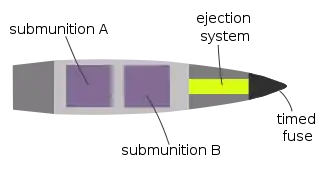| 155 mm BONUS | |
|---|---|
 BONUS 155 mm construction | |
| Type | Sensor‐fuzed submunition artillery projectile |
| Service history | |
| In service | Since 1990s |
| Used by | See operators |
| Production history | |
| Designer | Bofors AB |
| Designed | Early 1980s–1994 |
| Manufacturer | BAE Systems Platforms & Services |
| Produced | 2000 |
| Specifications | |
| Mass | 44.6 kg (98 lb) unfused |
| Length | 898 mm (35.4 in) unfused |
| Diameter | 155 mm (6.1 in) |
| Muzzle velocity | 830 m/s (2,723 ft/s) from 39‐caliber barrels |
| Maximum firing range |
|
| Filling | 2 x autonomous anti‐armour and anti‐artillery submunitions |
| References | Janes[1] |
155 BONUS ("Bofors Nutating Shell")[2] is a 155 mm artillery cluster round, developed in cooperation between Bofors of Sweden and Nexter of France, designed for a long range, indirect fire top attack role against armoured vehicles. Development on BONUS began in early 1985 as a study project for the Swedish Defence Material Administration, with an initial expectation of development completion by 1989 and production start by 1990.[3] By 1990, the development completion date had slipped to 1992.[4] The BONUS base bleed carrier shell contains two submunitions, which descend over the battlefield on winglets and attack hardened targets with explosively formed penetrator warheads.
Design

155 BONUS is a 155 mm NATO artillery round that consists of a 47-kilogram (104 lb) heavy artillery projectile containing two autonomous, sensor-fused, fire-and-forget submunitions.
After the submunition is released it opens two winglets. While descending, the submunition rotates, scanning the area below with multi-frequency infrared sensors and LiDAR[5] that compares the detected vehicles with a programmable target database. The submunitions each contain a high-penetration EFP warhead for use against even heavy armoured fighting vehicles like main battle tanks.
When fired from a 52-caliber barrel, a BONUS shell can travel up to 35 km (22 mi).[6][7]
Operation

| Phase | Picture | Description |
|---|---|---|
| 1 |  |
After setting range and target profile(s), the BONUS round is fired from a standard rifled 155mm artillery tube. |
| 2 | The round flies on a parabolic arc, with a range of up to 35 kilometres (21.7 mi) | |
| 3 | A timer fuse ignites a small ejector rocket in the nose, which drags the two submunitions out of the shell casing over the target area. | |
| 4 |  |
Once clear of the shell, the submunitions fall toward the target. The shell and the nose assembly fall away. |
| 5 |  |
The submunitions deploy winglets, and independently corkscrew down over the subject area with 900 rpm, scanning for targets. |
| 6 |  |
Once a submunition detects a target vehicle beneath it, it detonates its explosive payload, creating an explosively formed projectile which strikes the target vehicle's weak top armour. The high-velocity impactor penetrates the hull and kills or wounds the crew. |
Competing systems
BONUS is very similar to the German SMArt 155 system; SMArt 155 descends on a parachute rather than a system of winglets, and uses a millimeter radar as altimeter instead of LIDAR.
The United States developed the similar M898 SADARM system (which also descended on a ballute to attack the top surfaces of armoured vehicles), but this was discontinued in favour of the GPS guided M982 Excalibur round. US artillery largely deploys the M712 Copperhead laser-guided round for the anti-tank role.
Operators
 French Army - since 2000[8]
French Army - since 2000[8] Swedish Army - since 2000[8]
Swedish Army - since 2000[8] Finnish Army - since 2014[9]
Finnish Army - since 2014[9] US Army - being procured[10]
US Army - being procured[10] Norwegian Army[11]
Norwegian Army[11] Saudi Arabian National Guard, since 2012 (1,000 shells ordered in 2011)
Saudi Arabian National Guard, since 2012 (1,000 shells ordered in 2011) Ukrainian Ground Forces - since 2022
Ukrainian Ground Forces - since 2022 British Army - since 2023 - Adopted with Archer self propelled artillery system per UK MoD FOI answer in December 2023.
British Army - since 2023 - Adopted with Archer self propelled artillery system per UK MoD FOI answer in December 2023.
Operational history
It has been sent to Ukraine in aid packages by France and potentially Sweden and Norway.
Although rumours mentioned a kill on a Russian Pantsir-S1 system on July 5, 2022, it turned out that it was the SMArt 155 that hit it.[12]
In January 2023 photos of a 155 mm BONUS submunition was found in Ukraine. This is the first confirmed proof of their use in Ukraine.[13]
See also
References
- ↑ Janes (2 February 2022), "155 mm BONUS sensor‐fuzed munition", Janes Land Warfare Weapons: Ammunition, Coulsdon, Surrey: Jane's Group UK Limited., retrieved 6 August 2023
- ↑ Frost, Roger; Hewish, Mark (1986). "Defence 86 Show Report". International Defense Review. 19 (4): 495 – via Internet Archive.
- ↑ Frost, Roger; Hewish, Mark (1986). "Defence 86 Show Report". International Defence Review. 19 (4): 495 – via Internet Archive.
- ↑ "Sensor-fuzed anti-tank shell". International Defense Review. 25 (5): 580. 1990 – via Internet Archive.
- ↑ "155mm BONUS Anti-Armor, Top Attack Artillery" (PDF). Baesystems.com. Retrieved 17 July 2022.
- ↑ Roque, Ashley (19 October 2020). "BAE Systems proposes Archer for US Army's towed howitzer replacement competition". Jane's Information Group. Archived from the original on 27 March 2021. Retrieved 25 December 2020.
- ↑ US Army mobile howitzer shoot-off participants emerge. Defense News. 17 December 2020.
- 1 2 "Fritt Militärt Forum Nr 3 2000". Archived from the original on 4 March 2016. Retrieved 1 March 2015.
- ↑ "Finnish defence forces" (PDF). Archived from the original (PDF) on 19 April 2015. Retrieved 19 April 2015.
- ↑ Army Concerned Over Ban on Cluster Munitions, Land Mines - Military.com, 2 May 2017
- ↑ "Bofors 155mm BONUS Munition". Baesystems.com.
- ↑ "SMArt 155 in Action: Use of High-Precision Munitions to Eliminate russians is Geting Large-Scale (Video) | Defense Express". en.defence-ua.com. Retrieved 5 October 2022.
- ↑ Boyko Nikolov (4 January 2023). "Proven: Ukraine uses 155mm BONUS anti-tank shells with spaceship tech". bulgarianmilitary.com. Retrieved 5 October 2022.